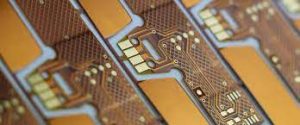Flexible Circuits Impact Energy Efficiency
Unlike rigid printed flexible circuits that must remain a static structure, flexible circuits are designed to bend and fold without impacting performance. This allows them to be utilized in many ways that aren’t possible with traditional rigid board technology. As a result, they offer more design flexibility and allow for an overall smaller package that can be assembled and shipped more efficiently.
The most notable difference between a standard PCB and a flex is in the materials used to construct the two types of circuits. In a typical flex circuit, the base layer is made from polyimide. This substance is known for its strength and reliability, offering crucial stability as well as exceptional mechanical and thermal resistance. The core of a flexible circuit is then constructed from copper foil. There are several types of copper films available, but the majority of flex circuits utilize Rolled Annealed copper (RAC). RAC provides an excellent balance between cost, physical and electrical properties, and etching speed.
Another key element to a successful flex circuit is the conductive copper film. There are two primary types: Electro Deposited and Rolled Annealed. While ED copper has superior electrical characteristics, it’s also more expensive than rolled annealed copper. Therefore, rolled annealed copper is the preferred choice for most FPCs.
A flex circuit is then printed with conductive patterns using one of a number of different printing technologies. Polymer thick film (PTF) flex circuits print single conductor layers on a polymer substrate separated by printed insulating layers. This allows for a high level of versatility in design, making it ideal for low power applications at slightly higher voltages, like the keyboard circuit found in an ATM or microwave oven. In contrast, polyester flex circuits are more suitable for dynamic application that require a constant bending such as those found in VR gloves.

How Do Flexible Circuits Impact Energy Efficiency?
Lastly, a laminate is added to both types of circuits. The laminate provides a barrier that prevents moisture, dust and other external contaminants from damaging the copper or affecting its conductivity. The most common laminates for a flexible circuit are polyimide and glass fabric. Polyimide is a flame retardant material that has excellent mechanical and chemical properties, while glass fabrics provide critical stability in dynamic applications.
Flex circuits also have the advantage of being able to be bended or flexed during installation and service without electronic failure. This is a significant benefit that can reduce reworking, testing and reject costs.
Another benefit of flex circuits is their ability to accommodate a wide range of components, including both plated through-hole and surface mounted devices. This capability to accept a wide variety of connections enables designers to choose the best arrangement that can fit into a specific space, thereby increasing the capacity for creative freedom and diversity.
Additionally, a flex circuit’s narrow lines and spaces can offer more room for device populations and lighter conductors compared to traditional PCBs. This can significantly lower the weight of an assembly and its energy requirements. This reduction in size often translates into reduced power requirements, further contributing to improved energy efficiency and an overall smaller carbon footprint.